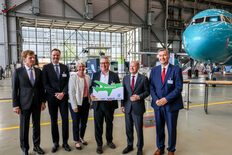- The project aims to produce 200,000 tonnes of eSAF annually, scalable to 500,000 tonnes.
- HH2E plans to establish 4 GW of green hydrogen production capacity in Germany by 2030.
- The initiative could reduce CO2 emissions by up to 1.58 million tonnes annually.
- Investments are expected to be in the billions, with a focus on East Germany.

Project Overview
Several companies from the energy and aviation sectors have signed an agreement to establish production capacities for sustainable aviation fuels (eSAF) in East Germany. The initial production target is 200,000 tonnes per year, with the potential to scale up to 500,000 tonnes. This initiative aims to reduce CO2 emissions by up to 1.58 million tonnes annually when fully operational.
Strategic Location
The eSAF production facility will be strategically located in East Germany to serve airports, including Leipzig/Halle. This location ensures convenient supply and supports Germany's role as a leader in decarbonized aviation.
Key Players
The collaboration includes DHL Group, HH2E AG, and Sasol, with Airbus potentially joining as an offtaker. DHL Group is expected to be a major consumer of the produced eSAF, contributing to its goal of achieving net-zero emissions by 2050.
Technological and Financial Plans
HH2E is setting up large-scale green hydrogen production plants, aiming for a 4 GW capacity by 2030. Sasol will introduce its Fischer-Tropsch technology for sustainable aviation fuels. The involved companies will immediately specify technical and financial planning, as well as regulatory frameworks, to realize eSAF production by 2030.
Economic and Environmental Impact
The project represents investments in the billions and promises significant benefits for climate protection, economic growth, job creation, and technological advancement in Germany and Europe. Successful implementation requires supportive framework conditions from the European Union and German federal and state governments to attract necessary private investments.

